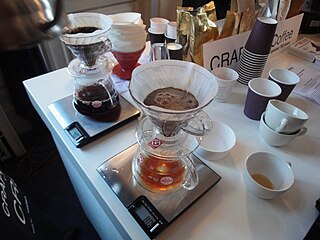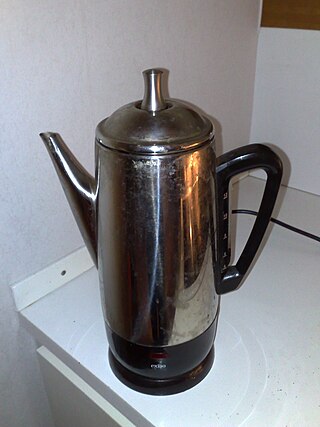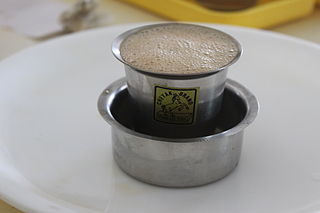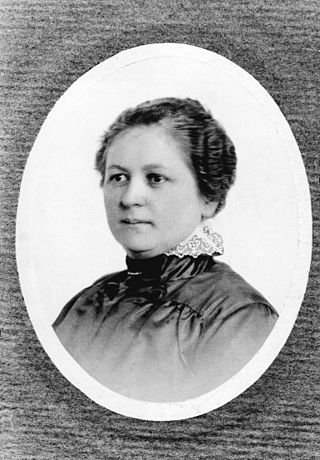Related Research Articles

A French press, also known as a cafetière, cafetière à piston, caffettiera a stantuffo, press pot, coffee press, or coffee plunger, is a coffee brewing device, although it can also be used for other tasks. The earliest known device was patented in 1852 in France by Jacques-Victor Delforge and Henri-Otto Mayer.

Drip coffee is made by pouring hot water onto ground coffee beans, allowing it to brew. There are several methods for doing this, including using a filter. Terms used for the resulting coffee often reflect the method used, such as drip-brewed coffee, or, somewhat inaccurately, filtered coffee in general. Manually brewed drip coffee is typically referred to as pour-over coffee. Water seeps through the ground coffee, absorbing its constituent chemical compounds, and then passes through a filter. The used coffee grounds are retained in the filter, while the brewed coffee is collected in a vessel such as a carafe or pot.

A coffee filter is a filter used for various coffee brewing methods including but not limited to drip coffee filtering. Filters made of paper (disposable), cloth (reusable), or plastic, metal or porcelain (permanent) are used. Paper and cloth filters require the use of some kind of filter holder, whereas filters made out of other materials may present an integral part of the holder or not, depending on construction. The filter allows the liquid coffee to flow through, but traps the coffee grounds.

A coffee percolator is a type of pot used for the brewing of coffee by continually cycling the boiling or nearly boiling brew through the grounds using gravity until the required strength is reached. The grounds are held in a perforated metal filter basket.

Indian filter coffee is a coffee drink made by mixing hot milk and sugar with the infusion obtained by percolation brewing of finely ground coffee powder with chicory in a traditional Indian filter. It has been described as "hot, strong, sweet and topped with bubbly froth" and is known as filter kaapi in India.

The Neapolitan flip coffee pot is a drip brew coffeemaker for the stove top that was very popular in Italy until the 20th century. Unlike a moka express, a napoletana does not use the pressure of steam to force the water through the coffee, relying instead on gravity.
Bunn-O-Matic Corporation is an American manufacturer of dispensed beverage equipment headquartered in Springfield, Illinois, with a plant in Creston, Iowa. The company was founded in 1957 by George R. Bunn, who designed his own versions of equipment that had been in existence for nearly fifty years: paper coffee filters and pour-over drip coffee brewers. Today, the corporation's products are sold under the BUNN and Bunn-O-Matic brands. The company's home coffeemakers are used throughout the United States and Canada, but the company's primary customers are institutional foodservice providers worldwide. The company introduced their first automatic drip-brew coffee maker in 1963. The company introduced their first drip brewer for the home market in 1972. The current president and CEO is Arthur H. Bunn.

Coffee preparation is the process of turning coffee beans into liquid coffee. While the particular steps vary with the type of coffee and with the raw materials, the process includes four basic steps: raw coffee beans must be roasted, the roasted coffee beans must then be ground, and the ground coffee must then be mixed with hot or cold water for a specific time (brewed), the liquid coffee extraction must be separated from the used grounds, and finally, if desired, the extracted coffee is combined with other elements of the desired beverage, such as sweeteners, dairy products, dairy alternatives, or toppings.

Amalie Auguste Melitta Bentz, born Amalie Auguste Melitta Liebscher, was a German entrepreneur who invented the paper coffee filter in 1908. She founded the company Melitta, which still operates under family control.

The AeroPress is a manual coffeemaker invented by Alan Adler, founder of AeroPress, Inc. It consists of a cylindrical chamber, and a plunger with an airtight silicone seal, similar to a syringe. Ground coffee beans and water are steeped inside, then forced through a filter at the bottom of the chamber by pressing the plunger down through the chamber. It is capable of brewing highly concentrated coffee, which the manufacturer describes as "espresso style", but can also be used to brew filter strength coffee, or cold brew coffee.

A single-serve coffee container is a container filled with coffee grounds, used in coffee brewing to prepare only enough coffee for a single portion. They come in various formats and materials, often either as hard and soft pods or pads made of filter paper, or hard aluminium and plastic capsules.
George J. Sowden is a designer and product developer.

A brewery or brewing company is a business that makes and sells beer. The place at which beer is commercially made is either called a brewery or a beerhouse, where distinct sets of brewing equipment are called plant. The commercial brewing of beer has taken place since at least 2500 BC; in ancient Mesopotamia, brewers derived social sanction and divine protection from the goddess Ninkasi. Brewing was initially a cottage industry, with production taking place at home; by the ninth century, monasteries and farms would produce beer on a larger scale, selling the excess; and by the eleventh and twelfth centuries larger, dedicated breweries with eight to ten workers were being built.

The Chemex Coffeemaker is a manual pour-over style glass coffeemaker, invented by Peter Schlumbohm in 1941, manufactured by the Chemex Corporation in Chicopee, Massachusetts.

A coffeemaker, coffee maker or coffee machine is a cooking appliance used to brew coffee. While there are many different types of coffeemakers, the two most common brewing principles use gravity or pressure to move hot water through coffee grounds. In the most common devices, coffee grounds are placed into a paper or metal filter inside a funnel, which is set over a glass or ceramic coffee pot, a cooking pot in the kettle family. Cold water is poured into a separate chamber, which is then boiled and directed into the funnel and allowed to drip through the grounds under gravity. This is also called automatic drip-brew. Coffee makers that use pressure to force water through the coffee grounds are called espresso makers, and they produce espresso coffee.

A chorreador is a coffee making device used in Costa Rica in which hot water leaches through coffee grounds held in a cloth filter mounted on a wooden stand, then drips into a container.

Cold brew coffee, also called cold water extraction or cold pressing, is the process of steeping coffee grounds in water at cool temperatures for an extended period. Coarse-ground beans are soaked in water for about 12 to 24 hours.
A variant of the category of French drip coffee pots is the group of "Bohemian" coffee pots, manual zero-bypass coffee makers made out of porcelain only, including Karlsbad coffee makers, Bayreuth coffee makers, the Walküre cup filter (2010) and the Walküre aroma-pot (2015). In contrast to French drip coffee pots they all use a special double-layered cross-slitted strainer made from through-glazed porcelain as well as a water spreader with six large round holes. Before World War I, they were very popular in the Viennese coffee house culture. The special kind of drip coffee they produce is called a Karlsbader.
"System Büttner" coffee makers have been a type of manual and semi-automatic coffee makers combining coffee steeping with drip-filtering (percolation).
References
- ↑ Green, Penelope (2010-09-19). "George Sowden, an Industrial Designer". The New York Times . Archived from the original on 2024-01-04. Retrieved 2024-01-04.
- ↑ "Sowden SoftBrew Coffee". Sowden at home. 2014. Archived from the original on 2024-01-04. Retrieved 2024-01-04.